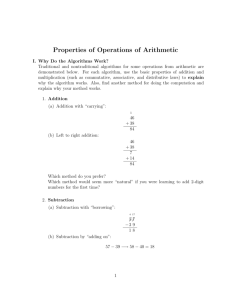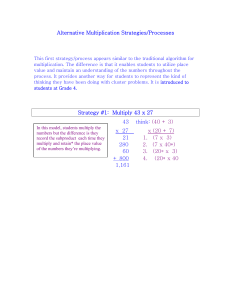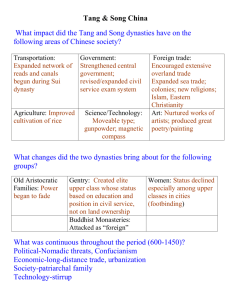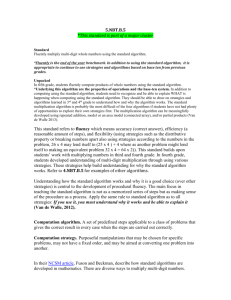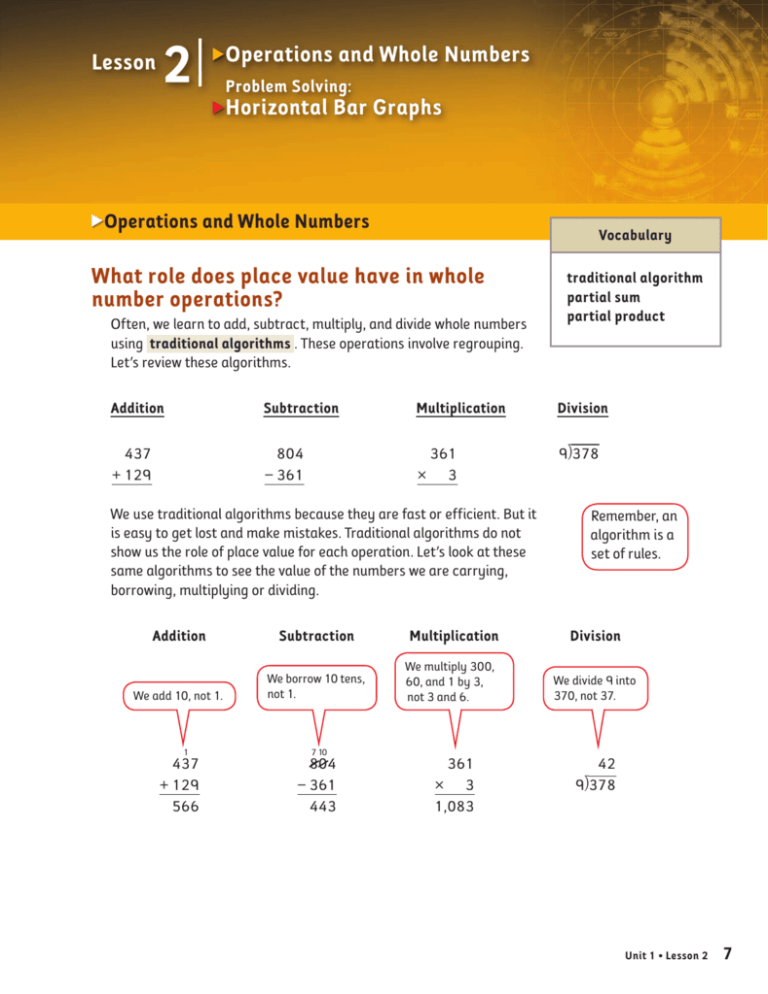
Lesson
2 Operations and Whole Numbers
Problem Solving:
Horizontal Bar Graphs
Operations and Whole Numbers
Vocabulary
What role does place value have in whole
number operations?
Often, we learn to add, subtract, multiply, and divide whole numbers
using traditional algorithms . These operations involve regrouping.
Let’s review these algorithms.
traditional algorithm
partial sum
partial product
Addition
Subtraction
Multiplication
Division
437
+ 129
804
361
361
3
9q378
We use traditional algorithms because they are fast or efficient. But it
is easy to get lost and make mistakes. Traditional algorithms do not
show us the role of place value for each operation. Let’s look at these
same algorithms to see the value of the numbers we are carrying,
borrowing, multiplying or dividing.
Addition
Subtraction
We add 10, not 1.
We borrow 10 tens,
not 1.
1
437
+ 129
566
7 10
804
361
443
Multiplication
We multiply 300,
60, and 1 by 3,
not 3 and 6.
361
3
1,083
Remember, an
algorithm is a
set of rules.
Division
We divide 9 into
370, not 37.
42
9q378
Unit 1 • Lesson 2 7
Lesson 2
How does expanded form help us see
place value?
We have learned that whole-number operations are also written in
expanded form. There’s less chance of making mistakes using the
expanded algorithm. It clearly shows the place value for each digit.
Let’s compare the traditional algorithm for addition with the expanded,
or partial sums , method.
Example 1
Use place value to add whole numbers.
We are not
adding 1.
We are
adding 10.
10
1
328
+ 465 793
S
300 20 8
+ 400 60 5
700 90 3
The expanded form shows how place value works. Place value becomes
very important when we have to regroup, or “borrow,” numbers. We
might make mistakes if we don’t think about place value.
Example 2
Use place value to subtract whole numbers.
We are not borrowing 1.
8 1
395
257 138
We are borrowing 10.
80
15
300 90 5
S − 200 50 7
100 30 8
We do not use the expanded method for everyday computation because
it is not efficient. But it is important to compare this method to the
traditional method. It reminds us what we are doing when we regroup
numbers.
8 Unit 1 • Lesson 2
In traditional algorithms,
it’s not clear that we
are adding a 10 or 100
because we just write a 1.
Lesson 2
Let’s compare the traditional algorithm for multiplication with
the expanded method. Another name for the expanded method is
the partial product method.
Example 3
Use place value to multiply whole numbers.
256
3
18
150
+ 600
768
We are not multiplying
2, 5, and 6 by 3.
200 50
×
S
+
6
3
18
150
600
768
We are multiplying
200, 50, and 6 by 3.
The result is the same for both algorithms.
The traditional method is quicker and more efficient. But it does
not clearly show what number we multiply by because we can’t see
the place value. Place value is much clearer with the partial product
method, but it has more steps.
These whole-number operations are important to understand as
we begin to learn about other types of numbers. We will have a
lot of practice with whole-number operations so we can become
more efficient.
Apply Skills
Reinforce Understanding
Turn to Interactive Text,
page 5.
Use the mBook Study Guide
to review lesson concepts.
Unit 1 • Lesson 2 9
Lesson 2
Problem Solving: Horizontal Bar Graphs
How do horizontal bar graphs differ from
vertical bar graphs?
Horizontal bar graphs work just like vertical bar graphs, but the
placement of the data is different. The scale is horizontal and is
numbered across the bottom. The labels go down the left side.
The following graph shows the speed of four race cars during one lap of
a race. The number of seconds it takes to get around the track is shown
on the horizontal axis. The team names are on the vertical axis.
Labels
Time of Race Cars for One Lap
Title
Olsen Racing
Team 7
Formula 1
Harmon Brothers
0
10 25
50
75 100 125 150 175 200
Seconds
Scale
Problem-Solving Activity
Reinforce Understanding
Turn to Interactive Text,
page 6.
Use the mBook Study Guide
to review lesson concepts.
Unit 1 • Lesson 2
Lesson 2
Homework
Activity 1
Solve each problem using expanded math.
1.
45
+ 26
2.
378
+ 183
3.
230
191
4.
96
3
Activity 2
Fill in the missing numbers in the table.
Starting Number
6,000
· 10
600 · 10
· 100
60 · 100
· 1,000
6 · 1,000
8,000
(a)
(b)
(c)
(d)
900 · 10
(e)
(f)
(g)
(h)
70 · 100
(i)
(j)
(k)
(l)
3 · 1,000
Activity 3 • Distributed Practice
Solve.
1.
469
+ 237
706
5.
9q459
2.
172
96
3.
76
6.
237
119
118
47
19
4.
893
7.
317
+ 185
267
8
2,136
8.
7q252
502
Copyright 2010 by Cambium Learning Sopris West®. All rights reserved. Permission is granted to reproduce this page for student use.
Unit 1 • Lesson 2 11

